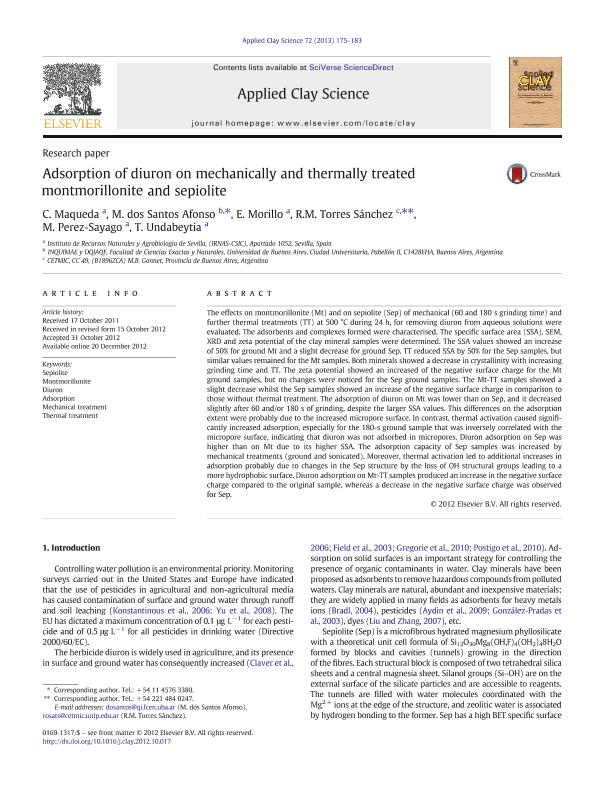Mostrar el registro sencillo del ítem
dc.contributor.author
Maqueda, C.
dc.contributor.author
Dos Santos Afonso, María
dc.contributor.author
Morillo, E.
dc.contributor.author
Torres Sanchez, Rosa Maria

dc.contributor.author
Perez Sayago, M.
dc.contributor.author
Undabeytia, T.
dc.date.available
2017-09-12T17:56:49Z
dc.date.issued
2013-01
dc.identifier.citation
Maqueda, C.; Dos Santos Afonso, María; Morillo, E.; Torres Sanchez, Rosa Maria; Perez Sayago, M.; et al.; Adsorption of diuron on mechanically and thermally treated montmorillonite and sepiolite; Elsevier Science; Applied Clay Science; 72; 1-2013; 175-183
dc.identifier.issn
0169-1317
dc.identifier.uri
http://hdl.handle.net/11336/24031
dc.description.abstract
The effects on montmorillonite (Mt) and on sepiolite (Sep) of mechanical (60 and 180 s grinding time) and further thermal treatments (TT) at 500 °C during 24 h, for removing diuron from aqueous solutions were evaluated. The adsorbents and complexes formed were characterised. The specific surface area (SSA), SEM, XRD and zeta potential of the clay mineral samples were determined. The SSA values showed an increase of 50% for ground Mt and a slight decrease for ground Sep. TT reduced SSA by 50% for the Sep samples, but similar values remained for the Mt samples. Both minerals showed a decrease in crystallinity with increasing grinding time and TT. The zeta potential showed an increased of the negative surface charge for the Mt ground samples, but no changes were noticed for the Sep ground samples. The Mt-TT samples showed a slight decrease whilst the Sep samples showed an increase of the negative surface charge in comparison to those without thermal treatment. The adsorption of diuron on Mt was lower than on Sep, and it decreased slightly after 60 and/or 180 s of grinding, despite the larger SSA values. This differences on the adsorption extent were probably due to the increased micropore surface. In contrast, thermal activation caused signifi- cantly increased adsorption, especially for the 180-s ground sample that was inversely correlated with the micropore surface, indicating that diuron was not adsorbed in micropores. Diuron adsorption on Sep was higher than on Mt due to its higher SSA. The adsorption capacity of Sep samples was increased by mechanical treatments (ground and sonicated). Moreover, thermal activation led to additional increases in adsorption probably due to changes in the Sep structure by the loss of OH structural groups leading to a more hydrophobic surface. Diuron adsorption on Mt-TT samples produced an increase in the negative surface charge compared to the original sample, whereas a decrease in the negative surface charge was observed for Sep.
dc.format
application/pdf
dc.language.iso
eng
dc.publisher
Elsevier Science

dc.rights
info:eu-repo/semantics/openAccess
dc.rights.uri
https://creativecommons.org/licenses/by-nc-sa/2.5/ar/
dc.subject
Sepiolite
dc.subject
Montmorillonite
dc.subject
Diuron
dc.subject
Adsorption
dc.subject
Mechanical Treatment
dc.subject
Thermal Treatment
dc.subject.classification
Ingeniería Oceanográfica

dc.subject.classification
Ingeniería del Medio Ambiente

dc.subject.classification
INGENIERÍAS Y TECNOLOGÍAS

dc.title
Adsorption of diuron on mechanically and thermally treated montmorillonite and sepiolite
dc.type
info:eu-repo/semantics/article
dc.type
info:ar-repo/semantics/artículo
dc.type
info:eu-repo/semantics/publishedVersion
dc.date.updated
2017-08-29T19:58:15Z
dc.journal.volume
72
dc.journal.pagination
175-183
dc.journal.pais
Países Bajos

dc.journal.ciudad
Amsterdam
dc.description.fil
Fil: Maqueda, C.. Consejo Superior de Investigaciones Cientificas; España
dc.description.fil
Fil: Dos Santos Afonso, María. Consejo Nacional de Investigaciones Científicas y Técnicas. Oficina de Coordinación Administrativa Ciudad Universitaria. Instituto de Química, Física de los Materiales, Medioambiente y Energía. Universidad de Buenos Aires. Facultad de Ciencias Exactas y Naturales. Instituto de Química, Física de los Materiales, Medioambiente y Energía; Argentina
dc.description.fil
Fil: Morillo, E.. Consejo Superior de Investigaciones Cientificas; España
dc.description.fil
Fil: Torres Sanchez, Rosa Maria. Provincia de Buenos Aires. Gobernación. Comision de Invest.científicas. Centro de Tecnología de Recursos Minerales y Ceramica. Consejo Nacional de Investigaciones Científicas y Técnicas. Centro Científico Tecnológico Conicet - la Plata. Centro de Tecnología de Recursos Minerales y Ceramica; Argentina
dc.description.fil
Fil: Perez Sayago, M.. Consejo Superior de Investigaciones Cientificas; España
dc.description.fil
Fil: Undabeytia, T.. Consejo Superior de Investigaciones Cientificas; España
dc.journal.title
Applied Clay Science

dc.relation.alternativeid
info:eu-repo/semantics/altIdentifier/doi/http://dx.doi.org/10.1016/j.clay.2012.10.017
dc.relation.alternativeid
info:eu-repo/semantics/altIdentifier/url/http://www.sciencedirect.com/science/article/pii/S0169131712002773
Archivos asociados
